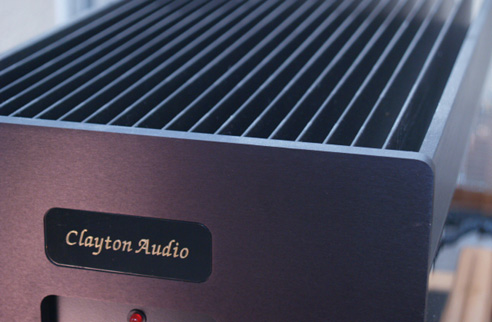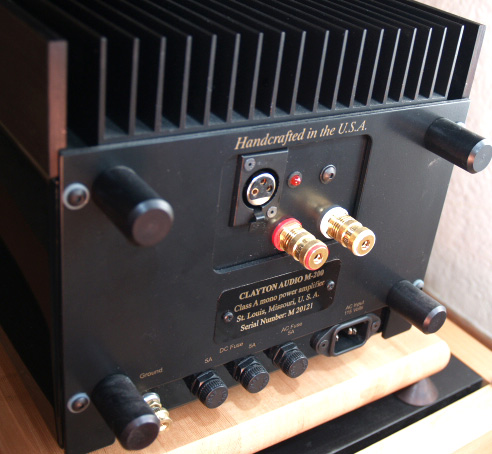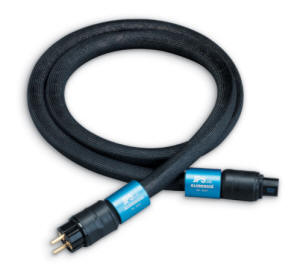|
You are reading the older HTML site Positive Feedback ISSUE september/october 2007
clayton audio M-200 Class-A amplifiers as reviewed by Dave Clark
| |||
|
|
A few issues back I wrote a brief intro to what was to be an actual full-fledged review of the new Clayton Audio M-200 amplifiers. Unfortunately, it has taken me a bit longer to complete the actual review for various personal reasons. Anyhow here is the scoop on the M-200 amplifiers... Uh… buy them. Or at least put them on a very, very short list of amplifiers to audition if you got the scratch. Inexpensive they are not, but they are worth every penny! Not good enough for ya? Well then, let's start from the beginning. Clayton Audio may be a new name to you, but not to us here at Positive Feedback Online. Head audio guru Wilson Shen (for more on Clayton and Wilson read an interview in Issue 33)—the man behind the black face-plates—has been in business as Clayton Audio for 11 years (aptly titled Clayton Audio because they are located in Clayton, Missouri). All their products run in Class-A and are rather unusual in their appearance by being more like large shoe boxes with top-sided heat sinks running front to back, than the typical rectangular box with side-mounted heat sinks. Round back are the usual IEC for the AC connection (I like the Claytons with JPS Aluminata AC cords), input connections, three fuses (I run mine with the HiFi Tuning fuses which allowed the M-100 and now the M-200 amplifiers to sound just that much better), a grounding post, and a red LED light to let you know the amps are on before you blow something up. Clean and simple.
I have had the pleasure of owning Clayton Audio amplifiers for a number or years now: first with the M-70 monoblocks (70-watts per channel), then upgrading these to the M-100 monoblocks (100-watts per channel). The upgrade was a simple (well, not that simple) boost in the power rating via a few internal parts swapping. The M-100 amplifiers are a stellar amplifier expanding upon the sonic and musical virtues of the M-70 amplifiers. I am not going to go into what they sounded like (you can read the reviews of the M-70 amplifiers here if you need more), but let me quote what was written by several current PFO reviewers way back in 1997…
That pretty much sums up what the M-100 amplifiers sound like, except any sense of current limiting or a dynamic glass ceiling of the M-70 amplifiers is gone. Dynamics and whatnot go up several notches… after all the M-100 amplifiers were passing on another 30-watts of pure Class-A power. Got to mean something. The M-100 amplifiers simply sound like a more powerful version of the M-70 amplifiers. Okay, but what does this have to do with the new Claytons… and what has Wilson been up to lately? Well after taking a way too long respite of sorts from audio (due to personal issues); he has come back strong with a new line-up based on all the previous models' strengths. Wilson wanted to improve upon as well as to address specific areas of the weaknesses in the previous models. Weaknesses that only a designer would appreciate, though I know sonically the new M-200 amplifiers are much, much better in every way than the M-100 amplifiers. The new M-200 amplifiers feature 200-watts of Class-A power at 8-ohms (400 @ 4 ohms), do not allow for a low-bias setting like the M-100 amplifiers did, and only accept XLR balanced connection. The M-200 amplifiers are a true balanced design featuring two identical mirrored Class-A amplifiers—one for each phase. Additionally, the M-200 amplifiers make use of separate power sources for the driver and output stages. The driver stage incorporates a high-precision regulation circuit for improved stability. The output stage is an extremely high current design using a π filter to enhance stability and minimize noise. No capacitors are used in the signal path. The M-200 amplifiers look just like the older M-100 amplifiers, though they feel like they might weigh a few pounds less. This is due to the new transformer (1KVA toroidal transformers with up to 160,000 microfarads of capacitance) that replaced the one used in earlier models. The problem is that the M-100 amplifiers were rather immune to DC in the AC, whereas the new M-200 amplifiers seem to respond rather poorly to this gremlin by humming a bit when DC enters into the line. Easy to solve by hunting down the cause and beating it a few times with a decent bat—unless it is the neighbor of course, though the thought has crossed my mind to deal with that problem the same way… or try a PS Audio unit that address DC. That works quite well.
Yes, the new amplifiers run hot (Wilson suggests that they will only get 55 degrees above the ambient room temperature—though they are thermally protected). Even so, they are built to be left on 24/7 if you can stand the heat and feel that being green is for weenies. Well… personally we try to be as green as possible and living in SoCal precludes the need to heat the house that much, so we leave the M-200 amplifiers off when not in use. Sorry to say though that they do sound better if warmed-up for a good hour or more, so gee… it would be nice to have the low-bias option allowing them to be ready to play at a minutes notice. Problem is that Wilson says the low-bias option actually imparted a degree of degradation to the sound, as did the RCA single-ended option, so minimal we go with the M-200 amplifiers. Regardless, if one is not green or has no need to save a few bills on their electricity, one can leave them on 24/7 as they are built to withstand the heat for a good 20-30 years before one has to worry about any component failures. Wilson has built to a very high military standard. I did find that a good 300-400 hours were necessary to shake any and all cobwebs from their circuits. Packing is first-rate, the manual is a bit sparse, and they worked right out of the box. Objective Position Objectively, these amplifiers are based on a Class-A design and require an AC cord to connect to an AC outlet. The choice of a Class-A design may or may not have any audible benefits over other designs such as Class-A/AB, D, C, or G. The M-200 amplifiers are inefficient and produce a large amount of heat as a by-product of their design (go here to learn more about Class-A and A/AB amplifiers). Even so, as an audio amplifier the M-200 amplifiers amplify an audio input signal producing sound at the loudspeakers. This amplification of the signal can be heard as music or noise (depending on your tastes and what you use as an input signal) possessing audio frequencies audibly flat from 20Hz to 20kHz. Any subtle deviation is moot as one can not hear such changes. With a gain of 26dB, they can either produce more or less of this music or noise depending on the input signal being reduced or increased at the preamplifier via a volume control as well as any other like amplifier. Input is only by XLR balanced connectors based on the amplifier's balanced design (input impedance is 100K ohms). This choice, and use of balanced cables, may or may not have any benefit over single-ended designs or other input options. Whether the M-200 amplifiers are audibly better than another amplifier is potentially a moot point as all well designed modern day amplifiers will measure so well (or practically the same) that any differences should be inaudible to the listener. Along with this, many measurements or claims as to circuit design and parts choices are irrelevant and are simply for marketing. They have no practical implications as to what and how the amplifier amplifies as long as it does it within acceptable measurable guidelines. Case in point is that the M-200 amplifiers are claimed to have virtually zero negative feedback. This might or might not mean anything in a DBT against other amplifiers that either possess this design artifact or not. The M-200 amplifiers' power rating specifications are acceptable for any practical load one might encounter in a realistic audio playback situation. The amplifier has shown itself to be stable and to not have any operational or electrical issues that would preclude its use in an audio situation. Of all the amplifiers I have used in my system, the M-200 amplifiers are certainly one of them (going way, way back and then back to the present, that would be: Blue Circle BC-6, Kora Titan monoblocks, NTA Calla monoblocks, Audio Magic Stealth 250 monoblocks, McIntosh MC352, Joule Electra Stargate monoblocks, Majeel Laboratories Pristine SA10, Audion Silver Night, Monarchy SM-70 monoblocks, Marsh A200s, Simaudio W-3, Marsh A450M monoblocks, Pass X250, Cary Audio 211 Anniversary Edition monoblocks, Edge Electronics G4, DK VS-1 MK 2 integrated amplifier, Edge G8m monoblocks, Audio Space 6M-KT88 monoblocks, and the Red Dragon Audio's Leviathan monoblocks, plus this or that, here and there). They amplify the signal and work fine with my speakers. Therefore, any audible preference for one amplifier over another is based purely on preconceived biases, illusions or delusions, misconceptions, and/or ignorance. You are a fool for liking one amplifier over another. You are an idiot and an impressionable (make that gullible) snob for spending what you can afford for what you want. You are easily fooled and can not actually be hearing what you think you are hearing. You are a liar and fraud in claiming to hear what you hear. Subjective Position The M-200 amplifiers take all that Francisco, Larry, and Victor wrote about with respect to the M70 amplifiers way back in 1997 and then move that up several notches... well not several notches, but a lot of notches… so many notches that comparing the two is rather irrelevant other than to say that if you liked earlier Clayton amplifiers, you are going to go gaga over these. The new M-200 amplifiers redefine what Clayton Audio can do with Class-A solid-state. They continue the Clayton house sound and build upon that in ways that one could never imagine: the M70 and M-100 were so damn good. The M-200s are quite simply one of the most wonderful amplifiers I have ever heard. They possess a very deep and powerful bottom-end, an airy and spacious high-end, all with a rich and natural tonality through the midrange. Speed and clarity are exemplary as they should be for a solid-state design, but the virtues of running straight Class-A means that one gets the benefits of solid-state and the glory of tubes—with little to nit-pick.
Okay so let's dig a bit deeper here. The M-200 amplifiers produce such rock-solid (think of a sharply defined massive boulder where the surface is clearly defined in natural clarity) slamming bass that is deeper, faster and more articulate (think nimble and agile), slamming (did I say that already?), punchier, even (no bloat or fullness), tactile (reach out and feel it), and visceral that my speakers are now able to really strut their stuff. We have always been able to impress visiting audiophiles and music lovers (the two are not all inclusive) with how well the speakers could rumble and energize the room with bass from this disc or that (say Yello, Laswell, Cheb i Sabbah, Badawi, and him to name just a few), but the new M-200 amplifiers almost make the older M-100 seem anemic. Well, not really, but playing old standards that impressed the locals has revealed just how impressive the Reimers are in terms of bass and dynamics… and how much we had been missing prior to the new M-200 amplifiers versus the older M-100 amplifiers (the Reimers use four 8.75” woofers per side in a dual isobaric chambers—two woofers per chamber). Now, all this bass energy/frequencies are experienced with nary a hint of sludge, bloat, an overly full mass of indistinct stomach churning crap that can impress so many, while being so wrong. No, the M-200 amplifiers do bass with a speed, clarity, and agility that is quite startling to hear. Bass starts and stops with a natural sense of quickness: dynamics (both in terms of micro- and macro-) possess an awareness of the edge defining shadings of the instruments' decay and presence that is clear and distinct. The M-200 amplifiers offer the nether region a rock-solid sense of control and definition that can be felt in your chest and stomach. Fast and clean they are! They lock onto the Reimers' woofers and won't let go. Bass-wise, they are without a doubt the best I have heard here in my system.
These are not detail freaking in-your-face amplifiers. They are not the “my God they are like a blinding light on the soundscape, can you hear that?” sort of amplifiers. Yes, they get all the details across—you can hear the tinkling of this and the tapping of that: things sound clear and distinct, things sound real and naturally portrayed in the soundscape. If it is there you will hear it as it was intended. It is just the M-200 amplifiers will not spotlight this or that, it will not cause you to freak out that you had never heard that before… though you might freak out that you never heard that sound like that before. Their tonal color is rather neutral: not white, not bleached or bare, never lean and stripped of life or color (though they are not a colored amplifier in the least, in that they do not appear to impart a sonic signature into the music). The M-200 amplifiers merely offer you the color and richness of what is on the disc or LP—they are honest, though they are not ruthlessly revealing. Simply put, their tonality is that of a well-balanced tube amplifier with no trade-offs: warm, natural, and full of life, but with solid-state control. They are clean and fast with no grain, grit, or crap. The treble is sweet and airy. Never sounding grainy and chalky (unless that was how it was recorded), the highs come across as they should: again what I heard is as close to my aural memory as I can recall. Things sound real and natural. There is no spotlighting and no added presence. The M-200 amplifiers do not sound bright, nor do they sound the least bit recessed. The high end sounds as a part of the complete sonic tapestry. Bright recordings will sound bright and those that are more well-balanced will sound as they should. Again the M-200 amplifiers are honest in what they do with regards to the top-end. They are not ruthless-revealing, nor are they forgiving—what you hear is what is there. But again, are they the best…? No, as the better tube amplifiers love to do the top-end with air out to the stratosphere. Yes, the Claytons come really, really close—so close for me that it is nothing more than a matter of close enough! when things get busy the M-200 amplifiers will not congeal, congest, or turn over and die. Toss the discs by the Budos Band, Antibalas, or any other big raucous amalgamation of instruments and the Claytons hold it all together. Rhythmically and dynamically they allow the music to unfold and propel the feeling of a big band blasting things out together. Yeah, the Claytons get that right! Pace and timing with each instrument holding its rightful place in a large ensemble, all working together to make one get up and dance. Cool
We have built a system knowing what we want in our music. We want it all and we want it balanced. The M-200 amplifiers are a complete amplifier that presents the music in an even, well-balanced tapestry. They are complete in the sense that everything sounds as it should with nothing jumping out at the listener. The M-200 amplifiers offer dynamics and tonal shadings to die for, offering neither too much or nor too little. They are easy to listen to when you feel the need to drift off, and they are easy to listen to when you feel need to get a good woody with your music! These are as involving (exciting) an amplifier as I have heard since the Cary Audio 211 Anniversary Edition monoblocks played center stage. The best summation I can offer came from a neighbor who is a professional bass player (electric and stand-up). In listening to the system one night, he remarked that what he was hearing was exactly what he had heard earlier when practicing with his stand-up bass. The tonality, presence, palpability, that essence that makes whatever sound right and real, was right there before him. The system was reproducing a stand-up bass in way that was real: he could see and feel a real person playing bass right there. Of course, one could argue that he is responding to the system and not just the amplifiers. Which is true to a great extent, but since he has heard the system in many configurations before, it is interesting that this session with M-200 amplifiers put him over the top. For him, this was it. The M-200 amplifiers were making the difference. Still it is a system, meaning that the M-200 amplifiers and everything else is working synergistically to do their thing—they match wonderfully here. But his response is still quite telling as to the M-200 amplifiers' abilities to recreate an event in one's room.
Are they perfect? We would have to define what we mean by perfect. Perfect for this system, this listener, this room, this music, this now? Well yes they are …they are pretty much perfect for us. Can't say that they would be perfect for you, but I can find little if anything to fault sonically. Sure they could always be a tad more of this and tad less of that, but we are talking about tads here: morsels, crumbs, specks, etc. This falls into the realm of synergy and tastes—or better put aural preferences. Simply put, they work mighty well here in forming a great synergy with the rest of the system, so perhaps they are more or less as perfect as a Class-A solid-state amplifier can be in today's audio reality …well at least my audio reality. No doubt I could bring some other amplifier that might sound even better than these do, hey there is a lot I have not heard and some that look mighty interesting …but till then these are the king on the block. Alright, but $9500 a pair!? The M-100s were $6500 and at that they were a steal (it should be noted that Wilson can not upgrade the M-100 to an M-200 due to differences in their designs and parts). Well, at $9500 we are entering the way up there how many can afford that price point range. But even at $9500 the M-200 amplifiers are a bargain. They are built like a tank right here in the States by Wilson and his assistants, they sound wonderful, and they have the appropriate fit n' finish. Yeah, they ain't flashy and all—they are quite understated in appearance - but Clayton has not cut any corners in their design (internal or external): what you get is what you need to get. So the issue of value is up to the individual. Hard for me to say what is of value to you based on what is of value to me, though I can certainly offer you my experience with them and what I heard. With that, you have to decide if the M-200 amplifiers are worth the price of admission … well, at least the price of an audition, I would hate for anyone to buy something simply because I liked it. After all I am just reporting on an experience succinctly and honestly while trying be somewhat entertaining (though some might disagree). Yeah, I sold the M-100 amplifiers and was able to purchase these at a price that we could all live with; meaning yeah, I got them at discount, but even at discount it was a lot of cash for us to part with. Would I have purchased them at full retail? Most definitely. No way could I have let these leave the house. Visa? Dave Clark
Clayton Audio Dealer Sales, Marketing, Technical Support:
TRI Audio Marketing
|






 The midrange is equally as impressive.
Images (voices, instruments, animals, furniture, or whatever…) appear in
free space with a great sense of palpability and thereness. No
grain or grit, no exaggerated forwardness or recession, no unevenness—things sound like they should from my memory of how real things
sounded in real space. Nothing stands out to make you aware that
something is amiss or to call attention to itself. Instruments are
portrayed naturally and in balance to each other. Vocals have a very
natural sense of chest and presence—like real people singing between the
speakers (take for example the vocals of Mimi Parker and Alan Sparhawk
or Low or those of Kurt Wagner of Lambchop). The M-200 amplifiers
are a tad more upfront or out-into-the-room than other amplifiers which
tend to portray the event as being further back in relation to the
speakers. Since we prefer this more forward perspective, the M-200
amplifiers fit the bill quite well thank-you. Are they best in this
area? I have heard the better tube amps do their magic and the Claytons
get awfully close. Even so, tubes can do it better, but it is so close I
really don't give a rat's ass. These are very remarkable solid-state
amplifiers.
The midrange is equally as impressive.
Images (voices, instruments, animals, furniture, or whatever…) appear in
free space with a great sense of palpability and thereness. No
grain or grit, no exaggerated forwardness or recession, no unevenness—things sound like they should from my memory of how real things
sounded in real space. Nothing stands out to make you aware that
something is amiss or to call attention to itself. Instruments are
portrayed naturally and in balance to each other. Vocals have a very
natural sense of chest and presence—like real people singing between the
speakers (take for example the vocals of Mimi Parker and Alan Sparhawk
or Low or those of Kurt Wagner of Lambchop). The M-200 amplifiers
are a tad more upfront or out-into-the-room than other amplifiers which
tend to portray the event as being further back in relation to the
speakers. Since we prefer this more forward perspective, the M-200
amplifiers fit the bill quite well thank-you. Are they best in this
area? I have heard the better tube amps do their magic and the Claytons
get awfully close. Even so, tubes can do it better, but it is so close I
really don't give a rat's ass. These are very remarkable solid-state
amplifiers.


 Quibbles? Well they do run hot. They are
susceptible to DC and one can have ground hum issues, but so can just
about anything else these days. They do benefit from quality AC cords
(like I said the JPS Aluminatas work well offering a balance of sorts
that works best for me… though the Kubala-Sosna Emotions offer a
slightly different balance that is also quite good …and I prefer the
amps straight from the wall with no AC filtration), RFI-EMI treatments
(say a Shakti Stone and On-Lines, or even the Acoustic Revive RGC-24
Ground Conditioner), and some sort of decent isolation (a quality amp
stand, cones, or feet to get what you want, though the M-200 amplifiers
do feature their own machined aluminum feet/pillars to sit upon). They
only accept balanced in, but since my system is balanced by design (CD
players and preamp are all true-balanced designs) why muck with things?
They are not all that inexpensive at $9500 a pair, but then again they
compete with amplifiers costing considerably more. These are stellar
products that will last you a life-time. Having experienced no serious
operational issues other than a hum here and there (all easy to deal
with); the M-200 amplifiers are as stable and non-temperamental as
anything else out there. No problems here. They work and play music.
Quibbles? Well they do run hot. They are
susceptible to DC and one can have ground hum issues, but so can just
about anything else these days. They do benefit from quality AC cords
(like I said the JPS Aluminatas work well offering a balance of sorts
that works best for me… though the Kubala-Sosna Emotions offer a
slightly different balance that is also quite good …and I prefer the
amps straight from the wall with no AC filtration), RFI-EMI treatments
(say a Shakti Stone and On-Lines, or even the Acoustic Revive RGC-24
Ground Conditioner), and some sort of decent isolation (a quality amp
stand, cones, or feet to get what you want, though the M-200 amplifiers
do feature their own machined aluminum feet/pillars to sit upon). They
only accept balanced in, but since my system is balanced by design (CD
players and preamp are all true-balanced designs) why muck with things?
They are not all that inexpensive at $9500 a pair, but then again they
compete with amplifiers costing considerably more. These are stellar
products that will last you a life-time. Having experienced no serious
operational issues other than a hum here and there (all easy to deal
with); the M-200 amplifiers are as stable and non-temperamental as
anything else out there. No problems here. They work and play music.